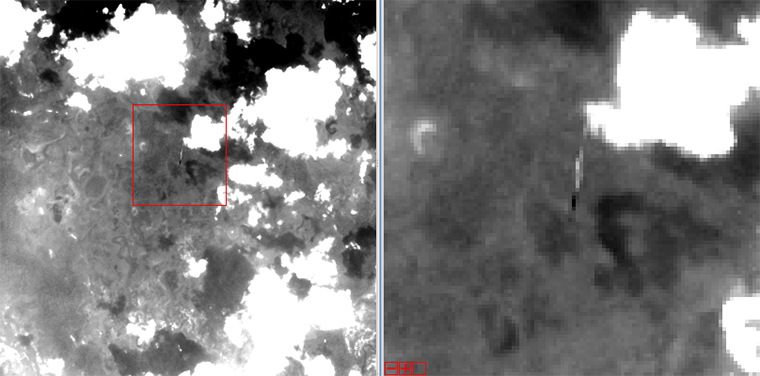
On November 22, 2013, Landsat 8 overflew the defunct Landsat 5 over northwestern Brazil (Path 233 Row 60). Thanks to some clever work by Mike Gartley, a Research Scientist with the Digital Imaging and Remote Sensing group at Rochester Institute of Technology (RIT)—a group that has long participated in Landsat calibration and validation—Landsat 5 was spotted in that Landsat 8 image.
In the image, the Landsat 5 satellite is seen as a streak of pixels (dark or light depending on the spectral band). There is one image from each of Landsat 8’s OLI bands—except for Band 7, or SWIR-2, where she blended into the clouds and was impossible to distinguish. In these images Landsat 5 is much closer to Landsat 8 than she is to the Earth.
+ Landsat 5 in Landsat 8 band 1, coastal, or true-blue, band
+ Landsat 5 in Landsat 8 band 2, blue band
+ Landsat 5 in Landsat 8 band 3, green band
+ Landsat 5 in Landsat 8 band 4, red band
+ Landsat 5 in Landsat 8 band 5, NIR band
+ Landsat 5 in Landsat 8 band 6, SWIR-1 band
+ Landsat 5 in Landsat 8 band 8, panchromatic band
+ Landsat 5 in Landsat 8 band 9, cirrus band
Correction: An earlier version of this article erroneously stated that image was collected “this week,” it was actually acquired on Nov. 22, 2013.
Further Information:
+ The Final Journey of Landsat 5: A Decommissioning Story
+ How to Manage a Satellite Going 17K MPH
+ Landsat 5 Sets Guinness World Record For ‘Longest Operating Earth Observation Satellite’

Be Part of What’s Next: Emerging Applications of Landsat at AGU24
Anyone making innovative use of Landsat data to meet societal needs today and during coming decades is encouraged to submit and abstract for the upcoming “Emerging Science Applications of Landsat” session at AGU24.





